
1910, 2010, 2210, 2310, 2510, and 2710 LCD Monitors
User Guide

1910, 2010, 2210, 2310, 2510, and 2710 LCD Monitors
User Guide
?? 2010
Company, L.P.
Microsoft, Windows, and Windows Vista are either trademarks or registered trademarks of Microsoft Corporation in the United States and/or other countries.
The only warranties for HP products and services are set forth in the express warranty statements accompanying such products and services. Nothing herein should be construed as constituting an additional warranty. HP shall not be liable for technical or editorial errors or omissions contained herein.
This document contains proprietary information that is protected by copyright. No part of this document may be photocopied, reproduced, or translated to another language without the prior written consent of
Second Edition (January 2010)
Document Part Number:

About This Guide
This guide provides information on setting up the monitor, installing drivers, using the
 WARNING! Text set off in this manner indicates that failure to follow directions could result in bodily harm or loss of life.
WARNING! Text set off in this manner indicates that failure to follow directions could result in bodily harm or loss of life.
 CAUTION: Text set off in this manner indicates that failure to follow directions could result in damage to equipment or loss of information.
CAUTION: Text set off in this manner indicates that failure to follow directions could result in damage to equipment or loss of information.
 NOTE: Text set off in this manner provides important supplemental information.
NOTE: Text set off in this manner provides important supplemental information.
iii
iv About This Guide

Table of contents
v
vi

1 Product Features
HP LCD Monitors
The HP LCD (liquid crystal display) monitors have an active matrix,
???Large diagonal display
???Maximum graphics resolution:
???1910m: 1366 x 768 @ 60Hz
???2010f: 1600 x 900 @ 60Hz
???2010i: 1600 x 900 @ 60Hz
???2010m 1600 x 900 @ 60Hz
???2210i: 1920 x 1080 @ 60Hz
???2210m: 1920 x 1080 @ 60Hz
???2310i: 1920 x 1080 @ 60Hz
???2310m: 1920 x 1080 @ 60Hz
???2510i: 1920 x 1080 @ 60Hz
???2710m: 1920 x 1080 @ 60Hz
???Plus
???VGA analog signal
???DVI digital signal
???
???Fast response time, providing better experience for hardcore gaming and graphics
???Easy viewing from a sitting or standing position, or while moving from one side of the monitor to the other
???Dynamic Contrast Ratio to provide deeper blacks and brighter whites for brilliant shading effects while gaming or watching movies
???Tilt adjustment
???Swivel adjustment
HP LCD Monitors 1

???Removable base and Video Electronics Standards Association (VESA) standard mounting holes for flexible mounting solutions, including
???Security lock slot for a locking security cable (security cable sold separately)
???Plug and Play capability, if supported by your computer system
???
???
???Keyboard parking
???Power Saver to reduce energy consumption
???Quick View settings display
???HDCP (High Bandwidth Digital Content Protection) on DVI and HDMI inputs (selected models)
???Software and utilities CD, containing the following:
???Drivers
???Auto adjustment software
???Documents
2 Chapter 1 Product Features

2 Safety and Maintenance Guidelines
Important Safety Information
A power cord is included with the monitor. If another cord is used, use only a power source and connection appropriate for this monitor. For information on the correct power cord set to use with the monitor, refer to the "Connecting the Power Cable" section in Setting Up the Monitor on page 7.
 WARNING! To reduce the risk of electric shock or damage to the equipment:
WARNING! To reduce the risk of electric shock or damage to the equipment:
???Do not disable the power cord grounding feature. The grounding plug is an important safety feature.
???Plug the power cord in a grounded (earthed) outlet that is easily accessible at all times.
???Disconnect power from the product by unplugging the power cord from the electrical outlet.
For your safety, do not place anything on power cords or cables. Arrange them so that no one may accidentally step on or trip over them. Do not pull on a cord or cable. When unplugging from the electrical outlet, grasp the cord by the plug.
To reduce the risk of serious injury, read the Safety and Comfort Guide. It describes proper workstation, setup, posture, and health and work habits for computer users, and provides important electrical and mechanical safety information. This guide is located on the Web at http://www.hp.com/ ergo and/or on the documentation CD, if one is included with the monitor.
 CAUTION: For the protection of the monitor, as well as the computer, connect all power cords for the computer and its peripheral devices (such as a monitor, printer, scanner) to some form of surge protection device such as a power strip or Uninterruptible Power Supply (UPS). Not all power strips provide surge protection; the power strips must be specifically labeled as having this ability. Use a power strip whose manufacturer offers a Damage Replacement Policy so you can replace the equipment, if surge protection fails.
CAUTION: For the protection of the monitor, as well as the computer, connect all power cords for the computer and its peripheral devices (such as a monitor, printer, scanner) to some form of surge protection device such as a power strip or Uninterruptible Power Supply (UPS). Not all power strips provide surge protection; the power strips must be specifically labeled as having this ability. Use a power strip whose manufacturer offers a Damage Replacement Policy so you can replace the equipment, if surge protection fails.
Use the appropriate and correctly sized furniture designed to properly support your HP LCD monitor.
 WARNING! LCD monitors that are inappropriately situated on dressers, bookcases, shelves, desks, speakers, chests, or carts may fall over and cause personal injury.
WARNING! LCD monitors that are inappropriately situated on dressers, bookcases, shelves, desks, speakers, chests, or carts may fall over and cause personal injury.
Care should be taken to route all cords and cables connected to the LCD monitor so that they can not be pulled, grabbed, or tripped over.
Safety Precautions
???Use only a power source and connection compatible with this monitor, as indicated on the label/ back plate of the monitor.
???Be sure the total ampere rating of the products connected to the outlet does not exceed the current rating of the electrical outlet, and the total ampere rating of the products connected to the power cord does not exceed the rating of the power cord. Look on the power label to determine the ampere rating (Amps or A) for each device.
???Install your monitor near a power outlet that you can easily reach. Disconnect the monitor by grasping the plug firmly and pulling it from the outlet. Never disconnect the monitor by pulling the cord.
???Do not allow anything to rest on the power cord. Do not walk on the cord.

Maintenance Guidelines
To enhance the performance and extend the life of the monitor:
???Do not open the monitor cabinet or attempt to service this product yourself. Adjust only those controls that are covered in the operating instructions. If the monitor is not operating properly or has been dropped or damaged, contact an authorized HP dealer, reseller, or service provider.
???Use only a power source and connection appropriate for this monitor, as indicated on the label/ back plate of the monitor.
???Be sure the total ampere rating of the products connected to the outlet does not exceed the current rating of the electrical outlet, and the total ampere rating of the products connected to the cord does not exceed the rating of the cord. Look on the power label to determine the ampere rating (AMP or A) for each device.
???Install the monitor near an outlet that you can easily reach. Disconnect the monitor by grasping the plug firmly and pulling it from the outlet. Never disconnect the monitor by pulling the cord.
???Turn the monitor off when not in use. You can substantially increase the life expectancy of the monitor by using a screen saver program and turning off the monitor when not in use.
???Slots and openings in the cabinet are provided for ventilation. These openings must not be blocked or covered. Never push objects of any kind into cabinet slots or other openings.
???Do not drop the monitor or place it on an unstable surface.
???Do not allow anything to rest on the power cord. Do not walk on the cord.
???Keep the monitor in a
???When removing the monitor base, you must lay the monitor face down on a soft area to prevent it from getting scratched, defaced, or broken.
Cleaning the Monitor
1.Turn off the monitor and the computer.
2.Unplug the monitor from the wall outlet.
3.Clean the monitor plastics with a clean cloth dampened with water.
4.Clean the monitor screen with an antistatic screen cleaner.
 CAUTION: Do not use benzene, thinner, ammonia, or any other volatile substances to clean the monitor or the screen. These chemicals may damage the cabinet finish as well as the screen.
CAUTION: Do not use benzene, thinner, ammonia, or any other volatile substances to clean the monitor or the screen. These chemicals may damage the cabinet finish as well as the screen.
Shipping the Monitor
Keep the original packing box in a storage area. You may need it later if you move or ship the monitor.
To prepare the monitor for shipping:
1.Disconnect the power, video, and audio cables from the monitor.
2.Set the monitor base on a soft, protected surface.
3.Hold the base with one hand, where it attaches to the rear of the monitor, and push the monitor forward, folding the monitor flat onto the soft, protected surface.
4.Place the monitor and base in the original packing box.

3 Setting Up the Monitor
Unpacking the Monitor
1.Unpack the monitor. Make sure all contents are included. Store the packing box.
2.Turn off the computer and other attached devices.
3.Determine whether the monitor will be desktop mounted or
4.Prepare a flat area to assemble the monitor. You may need a flat, soft, protected area for placing the monitor
5.You need a Phillips screwdriver for preparing the monitor for
Installing the Monitor
You can install the monitor on a desktop or
 NOTE: For displays with glossy bezels the user should consider the placement of the display as the bezel may cause disturbing reflections from surrounding light and bright surfaces.
NOTE: For displays with glossy bezels the user should consider the placement of the display as the bezel may cause disturbing reflections from surrounding light and bright surfaces.
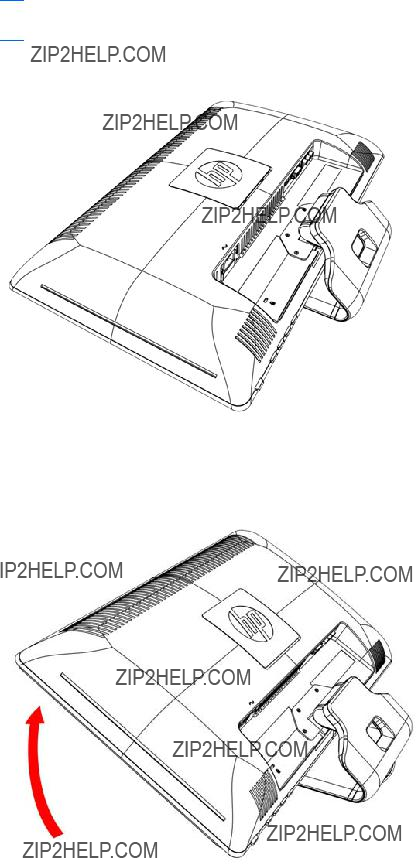
Preparing the monitor for desktop use
1.Set the monitor screen face down on a flat, soft, protected table or desk surface with the support column overhanging the edge.
 CAUTION: The screen is fragile. Avoid touching or applying pressure to the LCD screen; doing so can cause damage.
CAUTION: The screen is fragile. Avoid touching or applying pressure to the LCD screen; doing so can cause damage.
Figure
2.Grip the base near where it attaches to the monitor with one hand and lift the top part of the monitor until it is unfolded into the desired position.
Figure
8 Chapter 3 Setting Up the Monitor
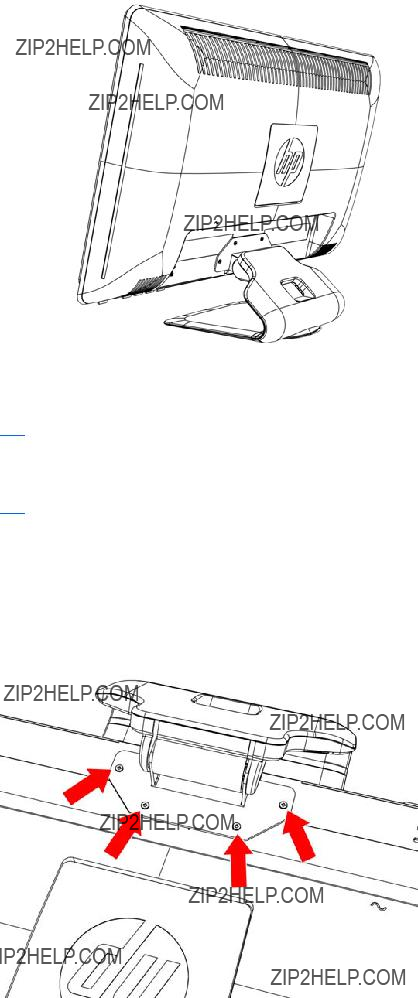
3.Lift the monitor to an upright position and place on a flat, stable surface.
Figure
Preparing the monitor for
1.Check the stability of the
 WARNING! To reduce the risk of personal injury or of damage to the equipment, check that the
WARNING! To reduce the risk of personal injury or of damage to the equipment, check that the
2.Disconnect the power cable and any other cables from the monitor.
3.Place the monitor face down on a flat, protected surface.
4.Remove the four screws that fasten the monitor base to the monitor.
Figure
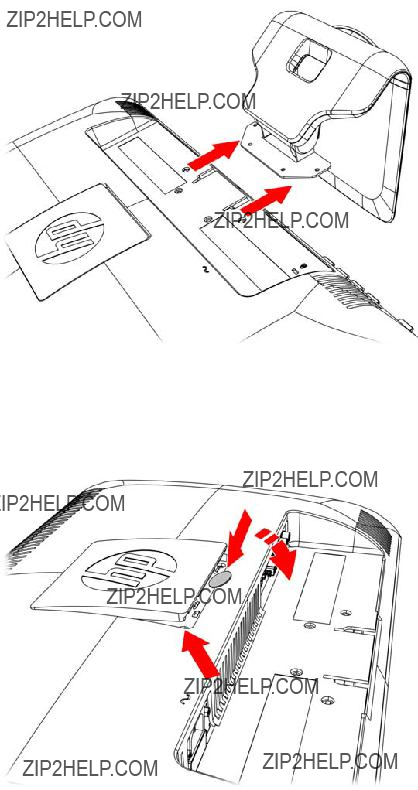
5.Slide the base away from the bottom of the monitor.
Figure
6.Remove the square plate on the back of monitor. Use a coin at the base of the plate to pry it loose.
Figure
10 Chapter 3 Setting Up the Monitor
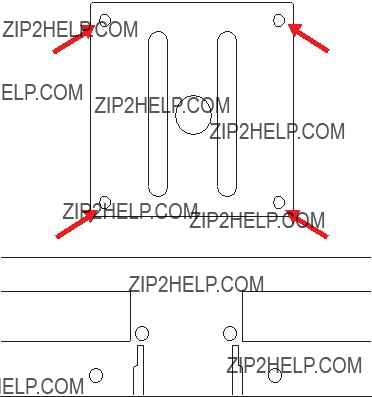
7.Four threaded holes are exposed. These holes are for screws to attach the swing arm or other mounting fixture to the back of the monitor.
Figure
8.Follow the instructions included with the mounting fixture to ensure that the monitor is safely attached.
The four threaded holes that are on the back of the panel are compliant with the VESA standard for mounting
9.Attach a swing arm or other mounting fixture.
Connecting Monitor Cables
Connecting the VGA (Analog) Cable or
Use a VGA video cable,
1.To connect the VGA cable (provided with select models)
Connect one end of the VGA video cable to the back of the monitor and the other end to the VGA video connector on the computer.
Connecting Monitor Cables 11

2.To connect the
Connect one end of the
Figure
 NOTE: When using a VGA or DVI signal, you must connect your audio separately because a VGA or DVI signal converts only video data, not audio data.
NOTE: When using a VGA or DVI signal, you must connect your audio separately because a VGA or DVI signal converts only video data, not audio data.
3.Connecting the HDMI Cable (provided with select models)
Connect one end of the HDMI cable (not provided) to the back of the monitor and the other end to a computer with an HDMI connector.
Figure
Your monitor supports HDCP and can receive
12 Chapter 3 Setting Up the Monitor

playing
Connecting the Audio Cable
Connect the
Figure
Connecting the Audio Cable 13
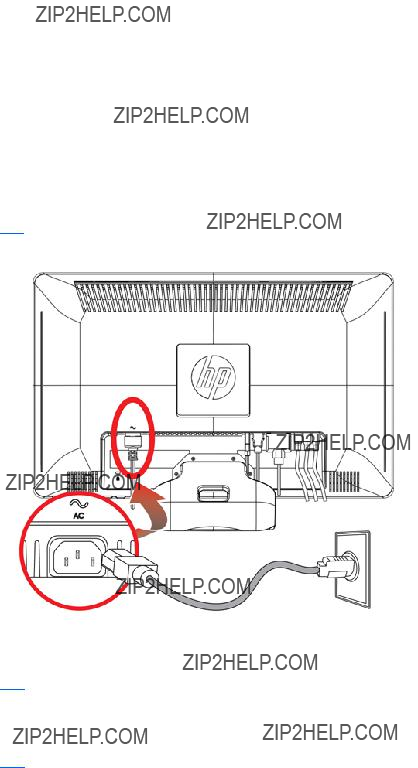
Connecting the Power Cable
1.Follow all electrical and power warnings:
 WARNING! To reduce the risk of electric shock or damage to your equipment:
WARNING! To reduce the risk of electric shock or damage to your equipment:
Do not disable the power cord grounding plug. The grounding plug is an important safety feature. Plug the power cord into a grounded (earthed) electrical outlet.
Be sure that the grounded power outlet you plug the power cord into is easily accessible to the operator and located as close to the equipment as possible. A power cord should be routed so that it is not likely to be walked on or pinched by items that are placed upon it or against it.
Do not place anything on power cords or cables. Arrange them so that no one may accidentally step on or trip over them. Do not pull on a cord or cable.
See Technical Specifications on page 31 (Appendix B) for additional information.
Figure
2.Connect one end of the power cable to the monitor and the other end to a grounded electrical outlet.
 WARNING! To prevent injury from electrical shock, you should do one of the following if a properly grounded electrical outlet is not available: (1) You should use an electrical outlet adapter that provides proper grounding. (2) You should have a properly grounded electrical outlet installed.
WARNING! To prevent injury from electrical shock, you should do one of the following if a properly grounded electrical outlet is not available: (1) You should use an electrical outlet adapter that provides proper grounding. (2) You should have a properly grounded electrical outlet installed.
Adjusting The Tilt
For optimal viewing, adjust the screen tilt to your own preference, as follows:
1.Face the front of the monitor and hold the base so that you do not topple the monitor while changing the tilt.
14 Chapter 3 Setting Up the Monitor
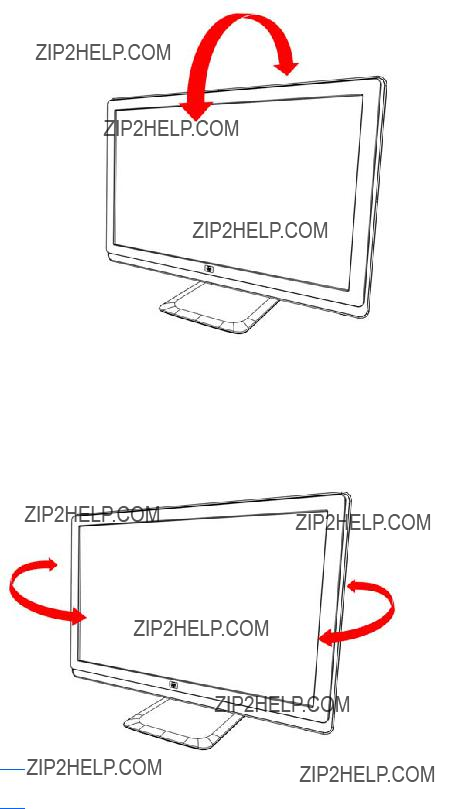
2.Adjust the tilt by moving the top edge of the monitor either toward or away from you, without touching the screen.
Figure
Adjusting the Swivel
The monitor allows a usable range of motion with the swivel feature.
Figure
 CAUTION: To avoid breakage or other damage, avoid applying pressure to the LCD screen while swiveling it or changing the tilt.
CAUTION: To avoid breakage or other damage, avoid applying pressure to the LCD screen while swiveling it or changing the tilt.
Adjusting the Swivel 15

Keyboard Parking
If you need more space on your desktop, place the keyboard under the monitor when not in use.
16 Chapter 3 Setting Up the Monitor

4 Operating the Monitor
CD Software and Utilities
The CD that is included with this monitor contains drivers and software that you can install on your computer.
Installing Drivers
If you determine that you need to update the drivers, you can install the monitor driver INF and ICM files from the CD, or download them from the Internet.
Installing the monitor driver software from the CD
To install the monitor driver software from the CD:
1.Insert the CD in your computer CD drive. The CD menu appears.
2.Select the language.
3.Click Install Monitor Driver Software.
4.Follow the
5.Ensure that the proper resolutions and refresh rates appear in the Display Control Panel settings. Refer to the Windows?? operating system documentation for more information.
 NOTE: You might need to install the digitally signed monitor drivers (INF or ICM files) manually from the CD, in case of an installation error. Refer to the "Driver Software Readme" file on the CD for instructions (in English only).
NOTE: You might need to install the digitally signed monitor drivers (INF or ICM files) manually from the CD, in case of an installation error. Refer to the "Driver Software Readme" file on the CD for instructions (in English only).
Downloading updated drivers from the Internet
To download the latest version of drivers and software files from the HP Support site:
1.Refer to: http://www.hp.com/support.
2.Select your country/region.
3.Select Download Drivers and Software.
4.Enter the model number of your monitor. The software download pages for your monitor are displayed.
5.Download and install the driver and software files by following the instructions on the download pages.
6.Ensure that your system meets the requirements.
CD Software and Utilities 17

Using the Auto Adjustment Function
You can easily optimize the screen performance for the VGA input by using the Auto/OK button on the monitor and the auto adjustment pattern software on the CD provided.
Do not use this procedure if your monitor is using a DVI or HDMI input. If your monitor is using a VGA input, this procedure can correct the following
???Fuzzy or unclear focus
???Ghosting, streaking, or shadowing effects
???Faint vertical bars
???Thin, horizontal scrolling lines
???
 CAUTION:
CAUTION:
To use the auto adjustment feature:
1.Allow the monitor to warm up for 20 minutes before adjusting.
2.Press the Auto/OK button on the monitor front panel.
???You can also press the Menu button, and then select Image Control, followed by Auto Adjustment from the OSD menu.
???If the result is not satisfactory, continue with the procedure.
3.Insert the CD in your computer CD drive. The CD menu displays.
4.Select the language.
5.Select Open Auto Adjustment Software.
6.The setup test pattern displays.
Figure
7.Press the Auto/OK button on the monitor panel to produce a stable, centered image.
18 Chapter 4 Operating the Monitor

Control buttons are located on the right front of the monitor:

Using the
An
1.If the monitor is not already on, press the Power button to turn on the monitor.
2.To access the OSD menu, press the Menu button. The OSD Main Menu displays.
3.To navigate through the Main or
 NOTE: The menu moves to the top if you scroll down at the bottom of the selections. The menu moves to the bottom if you scroll up at the top of the selections.
NOTE: The menu moves to the top if you scroll down at the bottom of the selections. The menu moves to the bottom if you scroll up at the top of the selections.
4.To adjust the scale of a selected item, press the + or ??? button.
5.Select Save and Return. If you don't want to save the setting, select Cancel from the
6.Press the Menu button to exit the OSD.
 NOTE: When a menu is displayed, if the buttons are untouched for 30 seconds (factory default), adjustments and settings are saved and the menu closes.
NOTE: When a menu is displayed, if the buttons are untouched for 30 seconds (factory default), adjustments and settings are saved and the menu closes.
OSD Menu Selections
The following table lists the
???Cancel ??? to return to the previous menu level.
???Save and Return ??? to save all changes and return to the OSD Main Menu screen. This Save and Return option is active only if you change a menu item.
???Reset ??? to change back to the previous setting.
20 Chapter 4 Operating the Monitor

Using the

22 Chapter 4 Operating the Monitor

Using the

24 Chapter 4 Operating the Monitor

Selecting Video Input Connectors
The input connectors are:
???VGA connector (analog)
???
???HDMI connector (select models)
The monitor automatically determines which inputs have valid video signals, and displays the image. You can connect the VGA cable, the
Identifying Monitor Conditions
Special messages appear on the monitor screen for the following monitor conditions:
???Input Signal Out of Range ??? Indicates the monitor does not support the video card's input signal because its resolution or refresh rate are set higher than the monitor supports.
Change your video card settings to a lower resolution or refresh rate. Restart your computer for the new settings to take effect.
???Monitor Going to Sleep ??? Indicates the screen display is entering a sleep mode. The speakers are turned off in sleep mode.
???Power Button Lockout??? Indicates the power button is locked. If the power button is locked, the warning message Power Button Lockout displays.
???If the power button is locked, press and hold the power button for 10 seconds to unlock the power button function.
???If the power button is unlocked, press and hold the power button for 10 seconds to lock out the power button function.
???Check Video Cable ??? Indicates a video input cable is not properly connected to the computer or monitor.
???OSD
Selecting Video Input Connectors 25
If the OSD is locked, press and hold the Menu button for 10 seconds to unlock the OSD. If the OSD is unlocked, press and hold the Menu button for 10 seconds to lock the OSD.
???Dynamic Contrast Ratio ONIndicates DCR is applied when Movie mode is selected from the Quick View options.
???Dynamic Contrast Ratio OFFIndicates DCR has been turned off when the monitor is changed to another viewing mode.
???No Input Signal ??? Indicates the monitor is not receiving a video signal from the computer on the monitor video input connector. Check to see if the computer or input signal source is off or in the
???Auto Adjustment in Progress ??? Indicates the auto adjustment function is active. See "Adjusting Screen Quality" in this chapter.
Adjusting Screen Quality
The auto adjustment feature automatically
If you want additional image quality improvement, use the Clock and Clock Phase controls of the monitor to fine tune the image. See "Optimizing Analog Video" in this chapter.
Optimizing Analog Video
Some monitors contain advanced circuitry that allow the monitor to function as a standard analog monitor. Two controls in the OSD menu can be adjusted to improve analog image performance:
???Clock ??? Increase or decrease the value to minimize any vertical bars or stripes visible on the screen background.
???Clock Phase ??? Increase or decrease the value to minimize video distortion or video jitter.
Use these controls only when the auto adjustment function does not provide a satisfactory monitor image in analog mode. To obtain the best results:
1.Allow the monitor to warm up for 20 minutes before adjusting.
2.Display the
3.Access the OSD menu, then select Image Control.
4.Set the main Clock settings correctly first, because the Clock Phase settings depend on the main Clock settings.
When adjusting the Clock and Clock Phase values, if the monitor images become distorted, continue adjusting the values until the distortion disappears.
To restore the factory settings, access the OSD menu, select Factory Reset, and then select
Yes.
26 Chapter 4 Operating the Monitor

When the monitor is in normal operating mode, the Power light is green and the monitor uses the normal watts of power. For power usage, refer to "Technical Specifications" (Appendix B).
The monitor also supports a
Refer to your computer documentation for instructions on setting
 NOTE: The
NOTE: The

A Troubleshooting
Solving Common Problems
The following table lists possible problems, the possible cause of each problem, and the recommended solutions:
Screen is black or displaying at a lower resolution while displaying
Check if your monitor and computer support HDCP. Refer to
28 Appendix A Troubleshooting

Getting Support from hp.com
Before you contact customer service, refer to HP Technical Support at: http://www.hp.com/support Select your country/region, and then follow the links to the support page for your monitor.
Preparing to Call Technical Support
If you cannot solve a problem by using the troubleshooting tips in this section, you might have to call technical support. For technical support contact information, refer to the printed documentation included with the monitor.
Getting Support from hp.com 29
Have the following information available when you call:
???Monitor model number (located on label on back of monitor)
???Monitor serial number (located on label on back of monitor or in the OSD display in the Information menu)
???Purchase date on invoice
???Conditions under which the problem occurred
???Error messages received
???Hardware configuration
???Name and version of hardware and software you are using
Locating the Rating Label
The rating label on the monitor provides the product number and serial number. You may need these numbers when contacting HP about your monitor model.
The rating label is on the back of the monitor.
30 Appendix A Troubleshooting

B Technical Specifications
All specifications represent the typical specifications provided by HP's component manufacturers; actual performance may vary either higher or lower.
HP LCD Monitors
Face treatment: Glare polarizer with hard coating
Input terminal:
???VGA connector
???
???HDMI connector (select models)
Table
Specifications:
HP LCD Monitors 31

Table
Specifications:
Table
Specifications:
Table
Specifications:
32 Appendix B Technical Specifications

Table
Specifications:
Table
Specifications:
HP LCD Monitors 33

Table
Specifications:
Temperature (independent of altitude)
Table
Specifications:
34 Appendix B Technical Specifications

Table
Specifications:
Preset Video Modes
The monitor automatically recognizes many preset video input modes that will appear properly sized and centered on the screen.
Table
Preset Video Modes 35

Table
Table
Table
LCD Monitor Quality and Pixel Policy
Your LCD Monitor uses
36 Appendix B Technical Specifications
A pixel consists of one red, one green, and one blue subpixel. A defective whole pixel is always turned on (a bright spot on a dark background), or it is always off (a dark spot on a bright background). The first is the more visible of the two. A defective subpixel (dot defect) is less visible than a defective whole pixel, and is small and only visible on a specific background.
To locate defective pixels, the monitor should be viewed under normal operating conditions and in normal operating mode at a supported resolution and refresh rate, from a distance of approximately 50 cm (16 inches). We expect that, over time, the industry will continue to improve its ability to produce displays with fewer cosmetic imperfections, and we will adjust guidelines as improvements are made.
For more information about your LCD Monitor and pixel policy, refer to the HP Web site at: http://www.hp.com/support. To find pixel policy information on the HP Web site, type in "HP Pixel Policy" in the search box and press Enter.
LCD Monitor Quality and Pixel Policy 37

C Agency Regulatory Notices
Federal Communications Commission Notice
This equipment has been tested and found to comply with the limits for a Class B digital device, pursuant to Part 15 of the FCC Rules. These limits are designed to provide reasonable protection against harmful interference in a residential installation. This equipment generates, uses, and can radiate radio frequency energy and, if not installed and used in accordance with the instructions, may cause harmful interference to radio communications. However, there is no guarantee that interference will not occur in a particular installation. If this equipment does cause harmful interference to radio or television reception, which can be determined by turning the equipment off and on, the user is encouraged to try to correct the interference by one or more of the following measures:
???Reorient or relocate the receiving antenna.
???Increase the separation between the equipment and the receiver.
???Connect the equipment into an outlet on a circuit different from that to which the receiver is connected.
???Consult the dealer or an experienced radio or television technician for help.
Modifications
The FCC requires the user to be notified that any changes or modifications made to this device that are not expressly approved by Hewlett Packard Company may void the user's authority to operate the equipment.
Cables
Connections to this device must be made with shielded cables with metallic RFI/EMI connector hoods to maintain compliance with FCC Rules and Regulations.
Declaration of Conformity for Products Marked with the FCC Logo (United States Only)
This device complies with Part 15 of the FCC Rules. Operation is subject to the following two conditions:
1.This device may not cause harmful interference.
2.This device must accept any interference received, including interference that may cause undesired operation.
For questions regarding the product, contact:
38 Appendix C Agency Regulatory Notices

Hewlett Packard Company
P. O. Box 692000, Mail Stop 530113
Houston, Texas
Or, call
For questions regarding this FCC declaration, contact:
Hewlett Packard Company
P. O. Box 692000, Mail Stop 510101
Houston, Texas
Or, call (281)
To identify this product, refer to the Part, Series, or Model number found on the product.
Canadian Notice
This Class B digital apparatus meets all requirements of the Canadian
Avis Canadien
Cet appareil num??rique de la classe B respecte toutes les exigences du R??glement sur le mat??riel brouilleur du Canada.
European Union Regulatory Notice
This product complies with the following EU Directives:
???Low Voltage Directive 2006/95/EC
???EMC Directive 2004/108/EC
Compliance with these directives implies conformity to applicable harmonized European standards (European Norms) which are listed on the EU Declaration of Conformity issued by
This compliance is indicated by the following conformity marking placed on the product:
This marking is valid for
This marking is valid for EU non- harmonized Telecom products.
*Notified body number (used only if applicable ??? refer to the product label).
Canadian Notice 39

The official EU CE declaration of conformity for this device may be found at http://www.hp.com/go/ certificates.
German Ergonomics Notice
HP products which bear the "GS" approval mark, when forming part of a system comprising HP brand computers, keyboards and monitors that bear the "GS" approval mark, meet the applicable ergonomic requirements. The installation guides included with the products provide configuration information.
Japanese Notice
Korean Notice
Power Cord Set Requirements
The monitor power supply is provided with Automatic Line Switching (ALS). This feature allows the monitor to operate on input voltages between
The power cord set (flexible cord or wall plug) received with the monitor meets the requirements for use in the country where you purchased the equipment.
If you need to obtain a power cord for a different country, you should purchase a power cord that is approved for use in that country.
The power cord must be rated for the product and for the voltage and current marked on the product's electrical ratings label. The voltage and current rating of the cord should be greater than the voltage and current rating marked on the product. In addition, the
A power cord should be routed so that it is not likely to be walked on or pinched by items placed upon it or against it. Particular attention should be paid to the plug, electrical outlet, and the point where the cord exits from the product.
40 Appendix C Agency Regulatory Notices

Japanese Power Cord Requirements
For use in Japan, use only the power cord received with this product.
 CAUTION: Do not use the power cord received with this product on any other products.
CAUTION: Do not use the power cord received with this product on any other products.
Product Environmental Notices
Materials Disposal
This HP product contains mercury in the fluorescent lamp in the display LCD that might require special handling at
Disposal of this material can be regulated because of environmental considerations. For disposal or recycling information, contact the local authorities or the Electronic Industries Alliance (EIA) http://www.eiae.org.
Disposal of Waste Equipment by Users in Private Household in the European Union
This symbol on the product or on its packaging indicates that this product must not be disposed of with your household waste. Instead, it is your responsibility to dispose of your waste equipment by handing it over to a designated collection point for the recycling or waste electrical and electronic equipment. The separate collection and recycling of your waste equipment at the time of disposal will help to conserve natural resources and ensure that it is recycled in a manner that protects human health and the environment. For more information about where you can drop off your waste equipment for recycling, please contact the local city office, the household waste disposal service or the shop where you purchased the product.
Chemical Substances
HP is committed to providing our customers with information about the chemical substances in our products as needed to comply with legal requirements such as REACH (Regulation EC No 1907/2006 of the European Parliament and Council). A chemical information report for this product can be found at http://www.hp.com/go/reach.
Product Environmental Notices 41
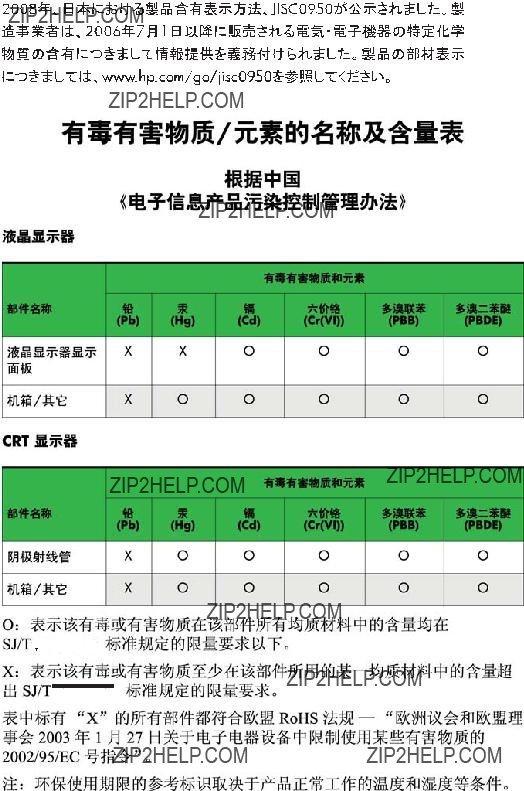
HP Recycling Program
HP encourages customers to recycle used electronic hardware, HP original print cartridges, and rechargeable batteries. For more information about recycling programs, go to http://www.hp.com/ recycle.
Restriction of Hazardous Substances (RoHS)
A Japanese regulatory requirement, defined by specification JIS C 0950, 2005, mandates that manufacturers provide Material Content Declarations for certain categories of electronic products offered for sale after July 1, 2006. To view the JIS C 0950 material declaration for this product, visit http://www.hp.com/go/jisc0950.
42 Appendix C Agency Regulatory Notices
Turkey EEE Regulation
In Conformity with the EEE Regulation
EEE Y??netmeli??ine Uygundur
Product Environmental Notices 43